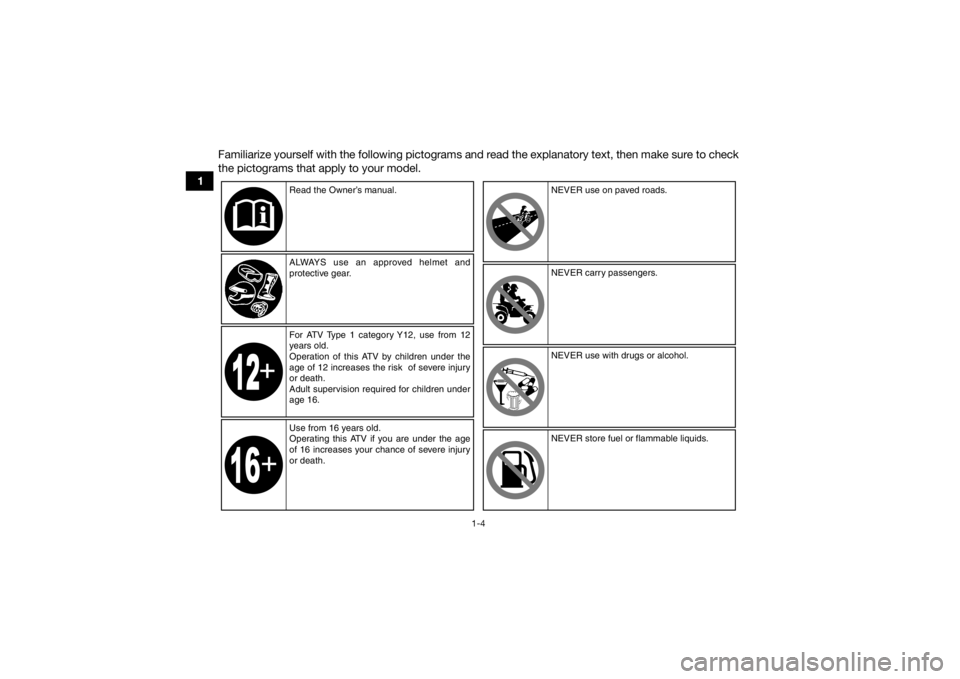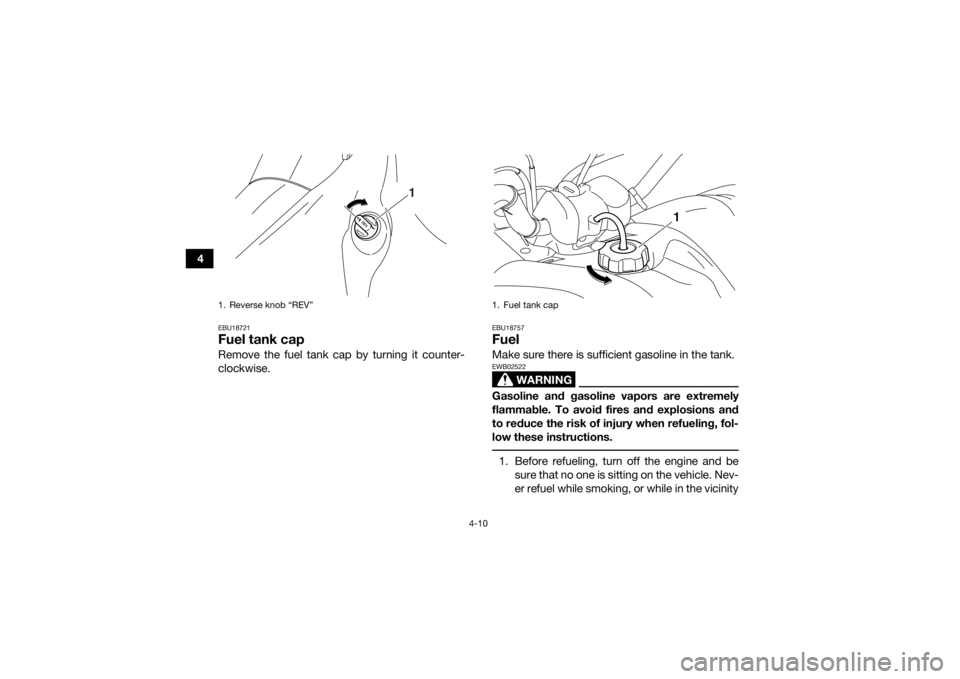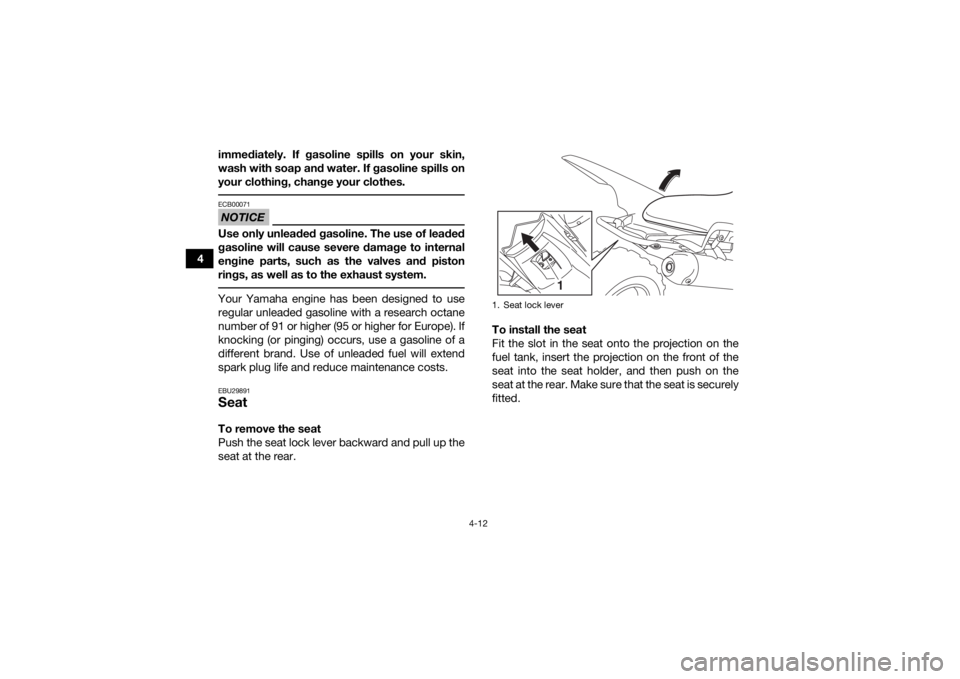fuel YAMAHA YFM700R 2015 Owners Manual
[x] Cancel search | Manufacturer: YAMAHA, Model Year: 2015, Model line: YFM700R, Model: YAMAHA YFM700R 2015Pages: 160, PDF Size: 3.78 MB
Page 8 of 160

EBU17421
TABLE OF CONTENTS
LOCATION OF THE WARNING AND
SPECIFICATION LABELS .............................. 1-1
SAFETY INFORMATION ................................ 2-1
DESCRIPTION................................................ 3-1Left view ...................................................... 3-1
Right view.................................................... 3-2
Controls and instruments............................ 3-3
INSTRUMENT AND CONTROL
FUNCTIONS ................................................... 4-1 Main switch ................................................. 4-1
Indicator lights and warning lights .............. 4-2
Self-diagnosis device .................................. 4-3
Handlebar switches .................................... 4-4
Throttle lever ............................................... 4-4
Speed limiter ............................................... 4-5
Clutch lever ................................................. 4-6
Brake lever .................................................. 4-6
Brake pedal ................................................. 4-7
Parking brake lever ..................................... 4-8
Shift pedal ................................................... 4-9
Reverse knob “REV” ................................... 4-9 Fuel tank cap ............................................ 4-10
Fuel ........................................................... 4-10
Seat .......................................................... 4-12
Adjusting the front shock absorber
assemblies (YFM700RF) ......................... 4-13
Adjusting the front shock absorber assemblies (YFM700RSF) ...................... 4-15
Adjusting the rear shock absorber assembly (YFM700RF)............................ 4-20
Adjusting the rear shock absorber assembly (YFM700RSF) ......................... 4-22
PRE-OPERATION CHECKS .......................... 5-1 Fuel ............................................................. 5-4
Engine oil .................................................... 5-4
Coolant ....................................................... 5-4
Front and rear brakes ................................. 5-4
Throttle lever ............................................... 5-5
Drive chain .................................................. 5-5
Tires ............................................................ 5-5
Chassis fasteners ....................................... 5-7
Instruments, lights and switches ................ 5-8U2LS60E0.book Page 1 Wednesday, June 18, 2014 11:12 AM
Page 14 of 160

1-4
1Familiarize yourself with the following pictograms and read the explanatory text, then make sure to check
the pictograms that apply to your model.
Read the Owner’s manual.
ALWAYS use an approved helmet and
protective gear.
For ATV Type 1 category Y12, use from 12
years old.
Operation of this ATV by children under the
age of 12 increases the risk of severe injury
or death.
Adult supervision required for children under
age 16.
Use from 16 years old.
Operating this ATV if you are under the age
of 16 increases your chance of severe injury
or death. NEVER use on paved roads.
NEVER carry passengers.
NEVER use with drugs or alcohol.
NEVER store fuel or flammable liquids.
U2LS60E0.book Page 4 Wednesday, June 18, 2014 11:12 AM
Page 23 of 160

2-4
2
Never maintain an ATV without proper knowl-
edge. Contact an authorized ATV dealer to in-
form you on basic ATV maintenance. Certain
maintenance can only be carried out by certified
staff.
In the event of an accident 1. If serious injuries are incurred, you may be safer staying next to your vehicle; it may
shield you from oncoming riders. Depending
on your injuries and position in the trail; you
must make a judgment call as to whether you
should move to a position off the trail. If you
have sustained head, neck, or back injuries,
or cannot feel your limbs, you should not
move. Keep your helmet on and remain mo-
tionless. Lie down next to your vehicle and
wait for help.
2. If less serious injuries are incurred and you can walk, then move to a position off the trail.
Check yourself for injuries and apply first aid
as needed.
3. If your injuries are light, when safe to do so, move your vehicle off the trail to avoid colli-
sions with oncoming riders. Check for injuries
and apply first aid as necessary. If you can
physically operate your vehicle, inspect your vehicle. If the vehicle is in safe operating con-
dition and you can safely operate it, restart it
and ride gently back to camp or other known
location where you can receive medical at-
tention. If necessary, contact your riding party
or local authorities to let them know where
you are and what has happened.
In the event of a breakdown 1. If your vehicle will not restart or is not in safe operating condition, turn off the main switch
and engine stop switch. If the breakdown oc-
curs at twilight or night, leave the main switch
on so that your lights may warn other riders of
your stopped vehicle.
2. Get out of danger. Check for oncoming vehi- cles and when safe, push your vehicle to the
side of the trail or even off the main trail to
avoid any possible collisions with oncoming
riders. If you cannot move your vehicle by
yourself, when safe, walk to the nearest van-
tage point and signal an oncoming rider to
help you push your vehicle to a safe place off
the trail.
3. Inspect your vehicle for any immediate haz- ardous conditions. The most obvious hazard-
ous conditions are leaking fuel and
U2LS60E0.book Page 4 Wednesday, June 18, 2014 11:12 AM
Page 24 of 160

2-5
2ungrounded or broken wiring. Visually check
for broken wiring and leaking fuel. Leaking
fuel can be confirmed by the odor of gasoline.
4. Once immediate safety hazards are con- firmed not to exist, you may remove your hel-
met to more closely inspect your vehicle.
Check for external signs of wear, broken
parts, fluid leaks, cracks in the frame, sus-
pension damage, wheel damage, and so on.
Fuel, oil, and coolant usually give off a notice-
able odor.
5. If your vehicle will not restart or if it is unsafe to ride, then turn off all vehicle systems (en-
gine stop switch, main switch, and fuel cock),
and then signal or go for help.
Aftermarket Parts, Accessories, and Modifica-
tions
While you may find aftermarket products similar in
design and quality to genuine Yamaha accesso-
ries, recognize that some aftermarket accessories
or modifications are not suitable because of po-
tential safety hazards to you or others. Installing
aftermarket products or having other modifica-
tions performed to your vehicle that change any of
the vehicle’s design or operation characteristics
can put you and others at greater risk of serious injury or death. You are responsible for injuries re-
lated to changes in the vehicle. Keep the following
guidelines in mind, as well as those provided un-
der “Loading” when mounting accessories.
Never install accessories that would impair the
performance of your ATV. Carefully inspect the
accessory before using it to make sure that it
does not in any way reduce ground clearance,
limit suspension travel, steering travel or control
operation.
Accessories fitted to the ATV can create insta-
bility due to improper weight distribution.
Bulky or large accessories may seriously affect
the stability of the ATV.
Certain accessories can displace the operator
from his or her normal riding position. This im-
proper position limits the freedom of movement
of the operator and may limit control ability,
therefore, such accessories are not recom-
mended.
Use caution when adding electrical accesso-
ries. If electrical accessories exceed the capac-
ity of the ATV’s electrical system, an electric
failure could result, which could cause a dan-
gerous loss of lights or engine power.
U2LS60E0.book Page 5 Wednesday, June 18, 2014 11:12 AM
Page 26 of 160

3-1
3
EBU17681
DESCRIPTION
EBU17691Left view1. Engine oil tank filler cap
2. Coolant reservoir
3. Fuel tank cap
4. Idle adjusting screw
5. Fuses
6. Rear shock absorber assembly rebound damping force adjusting screw (YFM700RSF)
7. Rear shock absorber assembly compression damping force adjusting bolt (for fast compression damping)
(YFM700RSF)
8. Rear shock absorber assembly compression damping force adjusting screw (for slow compression damping)
(YFM700RSF)
1 2
4
3
5
7,8
9
10
6
11
9. Rear shock absorber assembly spring preload adjusting
nut
10.Shift pedal
11.Engine oil tank drain bolt
U2LS60E0.book Page 1 Wednesday, June 18, 2014 11:12 AM
Page 30 of 160

4-2
4
EBU26696Indicator lights and warning lightsEBU17861Neutral indicator light “ ”
This indicator light comes on when the transmis-
sion is in the neutral position.EBU17831Reverse indicator light “ ”
This indicator light comes on when the transmis-
sion is in the reverse position.
EBU29922Coolant temperature warning light “ ”
This warning light comes on when the engine
overheats. When this occurs during operation,
stop the engine as soon as it is safe to do so and
allow it to cool down for about 10 minutes.
The electrical circuit of the warning light can be
checked by turning the key to “ ” (on). The
warning light should come on for a few seconds,
and then go off.
If the warning light does not come on initially when
the key is turned to “ ” (on), or if the warning
light remains on, have a Yamaha dealer check the
electrical circuit.NOTICEECB00011The engine may overheat if the ATV is over-
loaded. In this case, reduce the load to spec-
ification.
Start the engine after making sure that the
warning light is out. Continuous use while
the warning light is on may cause damage to
the engine.
1. Fuel level warning light “ ”
2. Engine trouble warning light “ ”
3. Coolant temperature warning light “ ”
4. Reverse indicator light “R”
5. Neutral indicator light “N”
12 34
5
U2LS60E0.book Page 2 Wednesday, June 18, 2014 11:12 AM
Page 31 of 160

4-3
4
EBU29932Fuel level warning light “ ”
This warning light comes on when the fuel level
drops below approximately 2.9 L (0.77 US gal,
0.64 Imp.gal). When this occurs, refuel as soon as
possible.
The electrical circuit of the warning light can be
checked by setting the engine stop switch to “ ”
and turning the key to “ ” (on). The warning light
should come on for a few seconds, and then go
off.
If the warning light does not come on initially when
the key is turned to “ ” (on), or if the warning
light remains on, have a Yamaha dealer check the
electrical circuit.EBU29943Engine trouble warning light “ ”
This warning light comes on or flashes when an
electrical circuit monitoring the engine is not work-
ing correctly. When this occurs, have a Yamaha
dealer check the self-diagnosis system.
The electrical circuit of the warning light can be
checked by turning the key to “ ” (on). The
warning light should come on for a few seconds,
and then go off.If the warning light does not come on initially when
the key is turned to “ ” (on), or if the warning
light remains on, have a Yamaha dealer check the
electrical circuit.
EBU30761Self-diagnosis deviceThis model is equipped with a self-diagnosis de-
vice for various electrical circuits.
If a problem is detected in any of those circuits,
the engine trouble warning light will come on or
flash. If this occurs, have a Yamaha dealer check
the vehicle.NOTICEECB01181To prevent engine damage, be sure to consult
a Yamaha dealer as soon as possible if this oc-
curs.
U2LS60E0.book Page 3 Wednesday, June 18, 2014 11:12 AM
Page 38 of 160

4-10
4
EBU18721Fuel tank capRemove the fuel tank cap by turning it counter-
clockwise.
EBU18757FuelMake sure there is sufficient gasoline in the tank.
WARNING
EWB02522Gasoline and gasoline vapors are extremely
flammable. To avoid fires and explosions and
to reduce the risk of injury when refueling, fol-
low these instructions. 1. Before refueling, turn off the engine and besure that no one is sitting on the vehicle. Nev-
er refuel while smoking, or while in the vicinity
1. Reverse knob “REV”
1
1. Fuel tank cap
1
U2LS60E0.book Page 10 Wednesday, June 18, 2014 11:12 AM
Page 39 of 160

4-11
4
of sparks, open flames, or other sources of
ignition such as the pilot lights of water heat-
ers and clothes dryers.
2. Do not overfill the fuel tank. When refueling, be sure to insert the pump nozzle into the fuel
tank filler hole. Stop filling when the fuel
reaches the bottom of the filler tube. Because
fuel expands when it heats up, heat from the
engine or the sun can cause fuel to spill out of
the fuel tank.
3. Wipe up any spilled fuel immediately.NOTICE: Immediately wipe off spilled fuel
with a clean, dry, soft cloth, since fuel may
deteriorate painted surfaces or plastic
parts.
[ECB00982]
4. Turn the fuel tank cap fully clockwise to make sure it is securely closed.
WARNING
EWB02532Gasoline is poisonous and can cause injury or
death. Handle gasoline with care. Never siphon
gasoline by mouth. If you should swallow some
gasoline or inhale a lot of gasoline vapor, or get
some gasoline in your eyes, see your doctor
1. Fuel tank filler tube
2. Maximum fuel level
1 2
Recommended fuel:
Regular unleaded gasoline only
For Europe: Regular unleaded gasoline only
with a research octane number of 95 or
higher
Fuel tank capacity: 11.0 L (2.91 US gal, 2.42 Imp.gal)
Fuel reserve amount: 2.9 L (0.77 US gal, 0.64 Imp.gal)
U2LS60E0.book Page 11 Wednesday, June 18, 2014 11:12 AM
Page 40 of 160

4-12
4immediately. If gasoline spills on your skin,
wash with soap and water. If gasoline spills on
your clothing, change your clothes.
NOTICEECB00071Use only unleaded gasoline. The use of leaded
gasoline will cause severe damage to internal
engine parts, such as the valves and piston
rings, as well as to the exhaust system. Your Yamaha engine has been designed to use
regular unleaded gasoline with a research octane
number of 91 or higher (95 or higher for Europe). If
knocking (or pinging) occurs, use a gasoline of a
different brand. Use of unleaded fuel will extend
spark plug life and reduce maintenance costs.EBU29891SeatTo remove the seat
Push the seat lock lever backward and pull up the
seat at the rear. To install the seat
Fit the slot in the seat onto the projection on the
fuel tank, insert the projection on the front of the
seat into the seat holder, and then push on the
seat at the rear. Make sure that the seat is securely
fitted.
1. Seat lock lever
1
U2LS60E0.book Page 12 Wednesday, June 18, 2014 11:12 AM